Posted by Anita on 01.28.09 9:16 PM
 We usually consume our oxtails in an Italian-style ragu. But with Chinese New Year upon us — and the Year of the Ox, at that — it seemed like an Asian preparation would be more appropriate.
We usually consume our oxtails in an Italian-style ragu. But with Chinese New Year upon us — and the Year of the Ox, at that — it seemed like an Asian preparation would be more appropriate.
In the world of Chinese oxtail recipes, the options generally boil down to either a hearty braise with root vegetables, or a simple long-simmered soup. In the latter, the meat is simmered for hours until it’s meltingly tender, then served in two parts, much like a French pot-au-feu: a platter of meat with a piquant dipping sauce, and a bowl of clear broth to fill the belly and provide a respite from the spicy, meaty main.
Usually, rice would accompany the meat, but in the spirit of the New Year celebration, we opted to add noodles — which signify long life — to the broth. If you’re not so keen on eating out of two separate bowls, you can pull the meat off the oxtails and stir it in with the noodles and broth, then serve with the sauce on the side for each diner to stir in as she chooses.

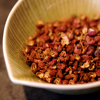



Sichuan Oxtail Soup
– adapted from Land of Plenty and Classic Food of China
2-1/2 to 3 pounds of meaty oxtail
2 chicken drumsticks (or any two pieces of dark meat)
3- to 4-inch piece of fresh ginger, unpeeled
2 tsp whole Szechuan peppercorns
1/2 cup Shaoxing wine (or medium-dry sherry), divided use
6-8 oz dry rice noodles (your choice of width)
salt to taste
– Sauce
1T peanut oil
1/4 cup Sichuan-style chili bean paste
2 tsp dark soy sauce
2 tsp sesame oil
Soak the oxtail pieces in cold water for 30 minutes, then discard the soaking water.
In a large, heavy-bottomed pan, bring 3 quarts of water to a boil. Add the oxtail and chicken, and return to a boil. Skim off any foam that floats to the top, then reduce heat to maintain a steady simmer, stirring occasionally and adding water as needed to keep the oxtails mostly submerged.
Smash the ginger with the back of a knife or other heavy object. Add it to the pan along with the peppercorns and 1/4 cup of the Shaoxing wine. Partially cover the pan, and simmer for at least 3 hours.
Meanwhile, prepare the sauce: Heat the peanut oil in a wok or skillet until very hot but not smoking. Add the chili bean paste, and stir fry until the oil is deep red and the sauce is fragrant. Pour the sauce into a heatproof bowl; when cooled, add the soy sauce and sesame oil.
At the end of the simmering time, the oxtail should be very tender and the meat will pull away from the bone but not completely separate from it. Remove the oxtails to a plate, discarding the simmered-out chicken parts. Pick off any peppercorns that stick to the oxtails and discard. Drain the broth through a fine seive, discarding the peppercorns and ginger, and return the clear dark broth to the pot. You should have about 6-8 cups of soup at this point; add additional cold water if needed, or simmer down the broth. Once you have the proper quantity, add the remaining 1/4 cup Shaoxing wine, then salt the broth to taste. Return the oxtails to the pan and gently reheat until very hot. (If you want to serve the soup in one bowl, pick the meat from the bones before returning it to the broth.)
Meanwhile, prepare the rice noodles according to package directions. (Usually this involves soaking the noodles in boiling water, as opposed to simmering them.) When cooked, divide the noodles among 4 soup bowls, then ladle the hot broth over them. Serve the oxtails in a separate large bowl or tureen, moistened with a bit of the broth, and allow each diner to choose their piece, eating it out of a rice bowl by pulling the meat off the bone and dipping it in the sauce to taste.
holidays & occasions, meat, recipes
10 Comments »




Posted by Anita on 01.26.09 2:25 PM
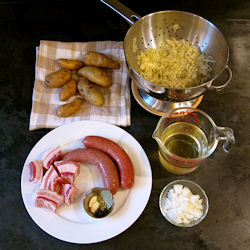 Along with our annual cassoulet, one of our favorite mid-winter traditions is simmering up a big pot of choucroute garnie — literally, garnished sauerkraut — in the Alsatian tradition. (Leave it to the French to come up with the brilliant idea of taking a delicious-but-homely pile of fermented cabbage and garnishing it with a pile of pork products.)
Along with our annual cassoulet, one of our favorite mid-winter traditions is simmering up a big pot of choucroute garnie — literally, garnished sauerkraut — in the Alsatian tradition. (Leave it to the French to come up with the brilliant idea of taking a delicious-but-homely pile of fermented cabbage and garnishing it with a pile of pork products.)
Every French traiteur worth his salted pork products keeps a giant crock of choucroute cru on hand, and it’s to this raw mixture that cooks will add their preferred mix of meats, wine, and seasonings. Here in the States, we have to look a little harder for the good stuff. At a minimum, start with refrigerated kraut — often found in bags or tubs near the chilled pickles at larger supermarkets. Even better would be to find a deli or artisan who sells fresh-fermented ‘kraut by the pint or the pound. However you source it, though, you want to start with crispy, bright shreds, not a mushy mash of greenish sog.
 Once you’ve found the appropriate vegetable matter, you need to consider your garnishes. Nearly every choucroute recipe calls for white wine, potatoes, bay leaf, and juniper berries; meaty additions typically include multiple kinds of sausage, as well as either ham or pork belly. Variations include apples, slices of smoked pork loin, and even duck confit. Like most home-style dishes, the exact ingredients are a matter of regional and personal preference; it’s almost impossible to go wrong.
Once you’ve found the appropriate vegetable matter, you need to consider your garnishes. Nearly every choucroute recipe calls for white wine, potatoes, bay leaf, and juniper berries; meaty additions typically include multiple kinds of sausage, as well as either ham or pork belly. Variations include apples, slices of smoked pork loin, and even duck confit. Like most home-style dishes, the exact ingredients are a matter of regional and personal preference; it’s almost impossible to go wrong.
There’s really only one problem with traditional choucroute: Its size. Don’t get me wrong: It’s a lovely thing to make when you’re feeding a crowd, and like so many peasant foods, leftovers are possibly even better than the original meal. But for a midweek supper, the usual cocotte trés grande is a bit of overkill. But if you find yourself with a some sauerkraut hanging around — perhaps after making a flight of Reuben sandwiches? — you can make a smaller, simpler version with a small bag of easily-sourced market goodies.
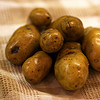

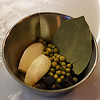


Petite Choucroute
– loosely adapted from Anthony Bourdain’s Les Halles Cookbook
1 pound good-quality sauerkraut (we like Alexander Valley Gourmet)
4 fingerling potatoes
2T lard or bacon fat
1 small onion, diced
5 juniper berries
2 small garlic cloves
1 small bay leaf
1/2 tsp coriander seed
1/2 bottle (1.5 cups) dry-but-fruity white wine, such as Riesling
2 sausages, approximately 1/2 pound (* see note)
8oz pancetta (or slab bacon, pork belly, etc.), cut into 2-inch chunks
Rinse the sauerkraut in cold water and drain well. Boil the potatoes until slightly firm; cut in half and set aside.
Heat the pork fat in a medium saucepan over moderate heat. Saute the onion until softened. Add the sauerkraut, aromatics, and wine, plus salt and pepper to taste. Cover and bring to a simmer. Add the pancetta; recover and simmer over lowest heat for 90 minutes. Place the potatoes on top of the choucroute, cut side down, and tuck into the simmering liquid. Put the sausages on top of the choucroute; cover again and simmer gently until the potatoes and sausage are warmed through.
To serve, spoon the choucroute into two warmed, shallow bowls, dividing the meats and potatoes evenly. Serve with spicy mustard on the site.
—
* We typically use Fatted Calf knockwurst to complement Boccalone pancetta. Feel free to improvise with the sausages you’re able to find locally, or even to choose different meats. Bear in mind you want some contrast between the flavors, but that they should play well together. If you’re using slab bacon, try a sausage that isn’t smoked or heavily salted, like a mild bockwurst. Other winning combos include garlic sausages with duck confit (add the latter at the end instead of simmering it), or ham hocks with boudin blanc. If you’re using unsmoked sausages, you’ll need to poach them before adding to the choucroute for the final simmer.
Dark Days challenge, locavore, meat, recipes
5 Comments »




Posted by Anita on 01.19.09 10:38 PM
 When you go to London, if you’re at all interested in the mixological arts, I recommend you bring an ample supply of cash, a large bottle of milk thistle, and a suitcase full of bubble wrap. Dear reader, they have so many wonders across the Pond that we only dream of Stateside.
When you go to London, if you’re at all interested in the mixological arts, I recommend you bring an ample supply of cash, a large bottle of milk thistle, and a suitcase full of bubble wrap. Dear reader, they have so many wonders across the Pond that we only dream of Stateside.
First among these treasures is a plethora of eye-poppingly gorgeous (not to say purse-poppingly pricey) cocktail establishments. The exchange rate is lately favourable to the American drinker, as much as can be possible. But a list of cocktails priced at £16, or £18, or even a heart-stopping £26 a sniff is bound to set even the hardiest of world travelers back on her heels. It was only the Christmas holidays and the attendant closure of many of the Capital’s top watering holes that saved us from coming home skint.
One of the key reasons for the allure of said establishments — apart from their five-star decor and their world-class staff — is the ability for a colonial to sample libations that simply never make it to our shores. Rare malts! Esoteric liqueurs! Cuban rums! The mind reels at the possibilities of the drinks that could be shaken, if only one had access to such wonders. (Happily, one does. Although London’s spirits emporia are small in number, they’re rich in merchandise, easily discovered, and more than happy to abuse your charge card in exchange for some very fragile cargo for the return flight.)
One of the best drinks we enjoyed while in London married both of these two alluring elements, the fantastically beautiful bar and the enticingly rare ingredient.
 Aided and abetted by another London treasure, Jay Hepburn — proprietor of the spectacular blog known as Oh, Gosh! — we spent an evening taxing the hospitality of not one but two of London’s luxury-hotel lounges, the Bar at The Dorchester and Connaught Bar. Though our night at The Dorchester will forever remain a highlight of our London trip (due in no small part to the extraordinary welcome we received from our gregarious barman, Stefano, and his flawless drinks that kept us so enraptured that we missed the last train of the night!), the Connaught was a stunner.
Aided and abetted by another London treasure, Jay Hepburn — proprietor of the spectacular blog known as Oh, Gosh! — we spent an evening taxing the hospitality of not one but two of London’s luxury-hotel lounges, the Bar at The Dorchester and Connaught Bar. Though our night at The Dorchester will forever remain a highlight of our London trip (due in no small part to the extraordinary welcome we received from our gregarious barman, Stefano, and his flawless drinks that kept us so enraptured that we missed the last train of the night!), the Connaught was a stunner.
It’s an opulent space, somehow embodying both splendid beauty and undeniably comfort. The staff are impeccable, gracious to a fault, and thoughtful to the utmost detail, from the first greeting to the last farewell. We were welcomed with a complimentary sip to enjoy while we perused the menu, then presented with a sheaf of recipes for the drinks we’d enjoyed at the end of the evening — an enchanting gesture that I hope will be the start of an international trend.
Though we savored many wonderful drinks that night, the final nod must go to the very first I tasted at Connaught Bar: a complex, spicy bit of exotica known as the French Sin. It’s not a simple drink to make, requiring a flavoured sugar, a barely seasonal fruit, a rare vermouth, and a carbonated tea infusion. Nevertheless, the rewards, as they say, are in the glass.
The French Sin also makes a perfect candidate for this month’s Mixology Monday: New Horizons, hosted by the anonymous Scribe of A Mixed Dram. Encouraged to sample a new spirit (amber vermouth, check!) or a new technique (carbonating tea — check again!), the French Sin covers all the bases. But if for some reason, you can’t be bothered to fizz your own tea, procure a bottle of rare vermouth, or infuse vanilla beans into sugar, never fear: The gentlemen of the Connaught Bar will be happy to oblige.


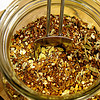


French Sin
– Connaught Bar, London
1/2 fresh fig
1/2T to 1T vanilla sugar
1-1/2 oz Armagnac
1/2 oz amber vermouth
3/4 oz lemon juice
3/4 oz rooibos spiced soda water
Muddle the fig in the shaker with the vanilla sugar, then add the rest of the ingredients — other than the spiced soda water — and shake with ice. Double-strain into a small goblet and top with rooibos spiced soda water, and stir briefly to combine. Garnish with a quarter of a fig.
—
If figs are out of season, look for the freshest dried figs available. Rehydrate them in a small amount of hot (not boiling) water until soft enough to muddle. For garnish, use a lemon twist or a yellow flower, reminiscent of a vanilla orchid.
Vanilla sugar can be purchased in gourmet shops or spice stores — Penzey’s makes a nice one, as does Nielsen-Massey. To make your own, grind a half of a dry vanilla bean in a spice grinder or coffee grinder with a small amount of granulated sugar. Add this vanilla powder to 1 cup sugar and let sit at least 24 hours (and preferably up to a week) before using. In this recipe, you can use the sugar as-is, since you’ll be straining the shaken mixture, but in baked goods or as a general sweetener, use a fine sieve to remove the larger pieces of vanilla pod after the infusing is complete.
To make the rooibos spiced soda, steep 4 tsp spiced rooibos tea (or 1T pure rooibos tea plus a few cardamom pods, whole peppercorns, and cloves) in a quart of hot water for 5 minutes. Strain, chill thoroughly, and charge in a soda siphon.
bar culture, coffee & tea, London, Mixology Monday, recipes
8 Comments »




Posted by Anita on 01.19.09 7:54 AM
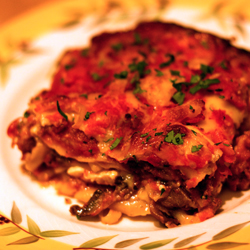 It must happen to everyone: That moment when you lose all ambition for trying new recipes and just fall back on the tried and true, the comfort foods that make your heart and belly happy, with a minimum of fuss.
It must happen to everyone: That moment when you lose all ambition for trying new recipes and just fall back on the tried and true, the comfort foods that make your heart and belly happy, with a minimum of fuss.
Last week, Cameron came down with a doozy of a cold. It wasn’t really terrible, in the symptoms department, but it seemed to go on forever and ever. It wasn’t the end of the world, but it was just annoying enough to keep him home, working at the dining room table and sipping mug after mug of lemon and honey. In much the same way, taking care of the house and the dogs all on my own isn’t really traumatic, but it is time-comsuming… and the thought of coming home and spending an hour or more in the kitchen — especially all alone — wasn’t terribly appealing. I looked for recipes that I could prep, preferrably in the morning or the night before, and then pop into the oven when I got home. And, of course, they had to appeal to the palate of a guy who had a head full of winter weather.
 Unfortunately for you, and for my narrative, the two all-local meals we ate last week were both repeats: My mom’s famous meatloaf — with Dirty Girl romanesco and baked Little’s potatoes on the side — and a thrown-together lasagna using home-canned tomatoes, locally made cheeses and fresh pasta.
Unfortunately for you, and for my narrative, the two all-local meals we ate last week were both repeats: My mom’s famous meatloaf — with Dirty Girl romanesco and baked Little’s potatoes on the side — and a thrown-together lasagna using home-canned tomatoes, locally made cheeses and fresh pasta.
For both of these meals, I took a slightly different route than my usual, mixing ground pork from our meat CSA with spices to make bulk sausage — home-grown sage for the meatloaf’s breakfast sausage, and home-grown fennel seed for the lasagna’s Italian sausage. Of course, the texture’s no match against real home-ground sausage, but in a highly flavored dish like lasagne, the difference is fairly negligible. And the taste? Comforting and hearty, just like always.



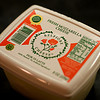

Quick Italian Sausage
1 pound ground pork (at least 30% fat)
1T kosher salt
1T fennel seed
1-1/2 tsp coarse black pepper
3/4 tsp sugar
2-3T ice cold water
Mix all ingredients together well. Fry a small test patty to taste for salt and seasoning, and adjust as needed. Let sit overnight, if possible, to allow flavors to blend.
Dark Days challenge, Italian, locavore, meat, recipes
5 Comments »




Posted by Anita on 01.12.09 7:22 PM
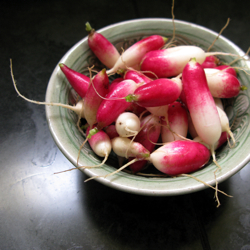 After two-plus weeks in London, we knew it was going to be difficult to get back to the grind, and the cold, grey weather here in San Francisco wasn’t doing anything to help us get over our jetlag.
After two-plus weeks in London, we knew it was going to be difficult to get back to the grind, and the cold, grey weather here in San Francisco wasn’t doing anything to help us get over our jetlag.
In a rare fit of travel wisdom, I’d planned our return for Saturday, to give us time to do little things like food shopping and laundry before heading back to work. But we arrived home far too late to get to our usual market at the Ferry Plaza, and the idea of trudging through a brightly lit supermarket didn’t seem the slightest bit appealing.
So after a fortifying Sunday morning breakfast, we headed across the Golden Gate bridge, in search of the Marin Civic Center farmers market. Even though this market isn’t much further from home than the downtown Berkeley market, we’d never checked it out. What we found was pretty impressive: A good number of stalls — maybe close to 100 — with a lot of variety, even in the middle of winter.
 We certainly had no problem finding meat. Marin Sun Farms was there, as were the Prather Ranch boys and Devil’s Gulch Ranch — a name we’ve seen on menus, but never bought; they don’t sell at the SF markets. By the time we arrived, all they had left was a big five-pound pork shoulder roast. We hemmed and hawed, then decided that we could make a big batch of carnitas and save the leftovers for a later meal. A vendor from San Luis Obispo — technically outside our challenge radius, but we fudged it — was selling avocados, and a bakery from Sacramento had corn tortillas; we’d made the right decision.
We certainly had no problem finding meat. Marin Sun Farms was there, as were the Prather Ranch boys and Devil’s Gulch Ranch — a name we’ve seen on menus, but never bought; they don’t sell at the SF markets. By the time we arrived, all they had left was a big five-pound pork shoulder roast. We hemmed and hawed, then decided that we could make a big batch of carnitas and save the leftovers for a later meal. A vendor from San Luis Obispo — technically outside our challenge radius, but we fudged it — was selling avocados, and a bakery from Sacramento had corn tortillas; we’d made the right decision.
We also picked up a pretty bone-in pork chop from Marin Sun, plus the usual assortment of vegetables and starches. Once we returned home, I popped the pork chop in my usual cider brine for a few hours. For our first Challenge meal of the week, we served it with mashed potatoes and a really nice chopped salad of romaine, avocado, radishes, carrots, and cucumbers, all tossed in a citrusy dressing and topped with grated dry Jack. (I was mimicking a salad I used to love ordering at Two before they went downhill, and I think I got pretty darned close.)
Every time I opened the fridge, that enormous pork shoulder was staring back at me. With a full week of evening commitments ahead, I quickly figured out that I’d bitten off more than I could chew; there just wasn’t time in our schedule for the full evening of patient simmering that carnitas requires. And with a slate of office projects piling up, there was no way I could work from home to coddle it.
I wondered aloud if the Crock-Pot might offer a solution, and Cameron agreed that it might be worth a try. “The worst thing that happens is you end up with pork stew.” A quick cruise around the Web didn’t really turn up much in the way of a trustworthy recipe, so I decided to wing it. I used our usual carnitas recipe, with a couple of changes: I left the meat in larger chunks to combat the tendency for everything to turn to mush. I also reduced the liquid — slow cookers retain a lot more moisture than even the best-sealed pots — and kicked up the brightness with a little citrus, to compensate for slow cooking’s flavor-dulling effect.
I’d popped the ingredients in the pot, then headed to the office, fully expecting to return home in about 8 hours to keep an eye on the tail end of the cooking process. Naturally, work dramas conspired against me, so it was nearly 12 hours later that I walked in the front door. A heavenly smell from the kitchen relieved some of my fears that I’d created a pile of overcooked, dry slop.
I shouldn’t have fretted. The part of the meat that wasn’t submerged got pretty toasty… an unexpected bonus. The rest of the meat was perfectly cooked, juicy and tender, with just enough connective tissue left to keep things together until you hit it with a fork.
In a traditional carnitas recipe, the braising liquid gets simmered down — with the meat in it — at the end of the cooking process; the meat gets nice and crispy in the fat that remains after the broth simmers away. To simulate this effect, we drained the juices and skimmed off the fat to sear the meat. And as a bonus, we have an ice-cube tray full of really yummy pork broth.





Crock-Pot Carnitas
4 pound boneless pork shoulder
1T whole cumin seed, lightly chopped or crushed
2 bay leaves
1 onion, quartered
1 cup rich pork or chicken stock
1 oz orange juice or Meyer lemon juice
salt, to taste
water, as needed
Cut the pork shoulder into large chunks, and sprinkle with the salt and cumin. Place in the Crock-Pot with the bay, onions, stock, and juice. Add enough water, if needed, to come halfway up the meat. Cover with lid, set pot on low, and cook for 10-12 hours, until meat is very tender.
Remove the meat from the pot and set aside in a warm place. Pour the cooking liquid into a fat separator, let settle, and then pour the defatted broth into a wide pan or baking dish to cool, reserving for another use. (Alternately, use a glass measuring cup and a turkey baster to separate the fat from the broth, or your usual fat-separating method.)
Heat a large skillet, and add enough of the skimmed carnitas fat to the pan to cover the surface well. Pull the meat apart, creating pieces approximately 1 inch long, and add to the pan once the fat is sizzling. Brown the meat until crispy on the outside, turning with tongs as needed. Remove each piece from the pan as it browns on all sides, keeping warm until ready to serve.
Serve with warm tortillas and your choice of condiments: salsa, chopped cilantro and onions, guacamole, sliced radishes, etc.
Dark Days challenge, farmers markets, locavore, meat, recipes
6 Comments »




Posted by Cameron on 01.06.09 10:09 PM
 It wasn’t easy to leave our newly planted crops germinating all on their lonesome as we took off for two weeks of well-deserved R&R on the far side of the Atlantic, but it was probably for the best. If nothing else, we were saved the agony of daily garden inspections in search of any signs of life. I briefly considered pointing a webcam at the back yard before we shuffled off to London, but discarded the idea after realizing that it would seriously creep out the housesitter, and that the camera’s resolution is so poor that I would be lucky to be able to pick out the raised beds, let alone any tiny green sprouts.
It wasn’t easy to leave our newly planted crops germinating all on their lonesome as we took off for two weeks of well-deserved R&R on the far side of the Atlantic, but it was probably for the best. If nothing else, we were saved the agony of daily garden inspections in search of any signs of life. I briefly considered pointing a webcam at the back yard before we shuffled off to London, but discarded the idea after realizing that it would seriously creep out the housesitter, and that the camera’s resolution is so poor that I would be lucky to be able to pick out the raised beds, let alone any tiny green sprouts.
So we returned from Albion with zero information, but plenty of hope. We dropped our luggage, played with the dogs for a minute or two, and then raced out to see if our backbreaking labor (ha!) had shown results. Happily, it had.
The radishes have come up like absolute gangbusters, sprouting delicate green tops and putting everything else to shame. The pea vines are running a close second, with two lines of tough, wiry — and at less than half an inch tall, seriously cute — stems that already look like they’re ready to wrestle a very tiny trellis into submission. The mixed lettuce is up and it’s kind of amazing to see how different all the different types look already, even though the largest leaf can’t be more than two millimeters across. A few of the onion sets are showing signs of life, and we even have a couple of green sparks showing in the leek trench.
So far, the laggards are the onion seeds and the beets. I’m not holding my breath on the former — everything that I’ve read says that onions are tough to grow from seed and that even when they are successful they take forever to germinate. I’m a bit puzzled about the beets, as they’re supposedly unfazed by cool weather, but it’s still pretty chilly at night and the seeds have only been in the ground for 20 days, 15 hours, and 33 minutes. But who’s counting?
And yes, that is frost that you see on the seedlings in the pictures. The Sunday morning after our first night back arrived with a coating of frozen crystals. A few days later, none of the little ones seem any the worse for wear. Since then, I’ve also discovered that I can stop frost from occurring at all simply by covering the plants to protect them — much the way that carrying an umbrella prevents rain from falling. Me and my magical frost cover are available for weddings, birthdays, and bar mitzvahs.





garden
8 Comments »




Posted by Anita on 01.03.09 7:53 PM
 When you live on an island that’s a mere 300 miles wide, local food is a relative thing. In the map to the left, the blue pin shows the location of our London flat. The green circle — which touches the Normandy coast of France — shows a 100-mile radius; yellow encompasses 150 miles, and blue — which grazes Paris! — illustrates the 200-mile radius that many wintertime eat-local challenges allow.
When you live on an island that’s a mere 300 miles wide, local food is a relative thing. In the map to the left, the blue pin shows the location of our London flat. The green circle — which touches the Normandy coast of France — shows a 100-mile radius; yellow encompasses 150 miles, and blue — which grazes Paris! — illustrates the 200-mile radius that many wintertime eat-local challenges allow.
Looks like it would be easy to eat local, doesn’t it? I’m sure with a little practice and a bit of hunting, it definitely could be. But when you’re on holiday and have no understanding of where cities, counties, and postcodes are situated within Britain, it’s definitely a challenge. And when we discovered that most of London’s farmers markets run on a reduced schedule and roster for the run-up to Christmas, we thought we might have to call a vacation hiatus on making our weekly Dark Days meal from all-local ingredients.
Our biggest shock came on an afternoon trip to the world-famous Borough Market, the place we assumed would be the highlight of our shopping excursions. But although it’s still a feast for the eyes, it’s definitely taken on a more-corporate feeling since our last visit. And despite the wealth of delectables on offer, we found it nearly impossible to unearth items grown or produced local to London. One very pleasant exception: Mrs King’s gorgeous raised-crust pork pies are made in the appellation-controlled region of Melton Mowbray, about 90 miles from London.
Most of the bread we found, at Borough and in shops, was baked either on the outskirts of London, or in nearby Oxfordshire. Once we got a little basic geography under our belts, finding local ales and ciders was easy-peasy, even in the big supermarkets. And many well-regarded packaged products — preserves, pickles, mustards, crackers, cookies, and so forth — are made in Britain, if not within southern England per se.
 If you’re willing to leave the foodie haunts and supermarkets behind, the news gets better. FARMA-certified London Farmers’ Markets have some of the most thorough guidelines I’ve ever seen, touching on everything from permissible ingredients in artisan goods to animal welfare to to maximum distances traveled: Everything sold must be “raised, grown, produced, gathered, caught, or baked within 100 miles of the M25”, London’s exterior beltway. Even on a very slow week at the Marylebone Farmers Market, we were able to cobble together a full meal: Sausages (produced on Food Fore Thought‘s East Sussex farm, using their own-raised pork), Brussels sprouts, and potatoes, which we served with a store-bought bottle of real ale from Hook Norton in Oxfordshire, 81 miles from London.
If you’re willing to leave the foodie haunts and supermarkets behind, the news gets better. FARMA-certified London Farmers’ Markets have some of the most thorough guidelines I’ve ever seen, touching on everything from permissible ingredients in artisan goods to animal welfare to to maximum distances traveled: Everything sold must be “raised, grown, produced, gathered, caught, or baked within 100 miles of the M25”, London’s exterior beltway. Even on a very slow week at the Marylebone Farmers Market, we were able to cobble together a full meal: Sausages (produced on Food Fore Thought‘s East Sussex farm, using their own-raised pork), Brussels sprouts, and potatoes, which we served with a store-bought bottle of real ale from Hook Norton in Oxfordshire, 81 miles from London.
And in the world beyond all-local, the news is better still. Even in mainstream supermarkets like Waitrose and Sainsbury’s, it’s easy to find cage-free eggs and pastured chickens; a solid majority of carton eggs sold in the UK are cage-free. Thanks to many campaigns by celebrity chefs like Jamie Oliver and Hugh Fearnley-Whittingstall, Britons are by now far more aware of the intrinsic cruelty of the battery hen system than the average consumer here at home. And in England, organic certification — the kind you see stamped on supermarket chickens — means more. It’s not just a simple matter of feeding Chinese organic soy to your animals; the Soil Association (Britain’s main certification agency) guidelines call not just for a cage-free environment, but true “freedom to range”.
Lest you think this means a giant warehouse with a tiny door to a barren yard, the guidelines actually stipulate that birds may not even be permanently housed, and that their forage must be “well-covered with suitable vegetation”. And SA-certified poultry isn’t just something you’ll find in posh shops: Even on the New Year’s Day bank holiday, we had no trouble finding SA-certified organic chicken parts in a ‘Sainsbury Local’, a neighborhood grocery the size of a 7-11. We couldn’t find any evidence that this meat was local to us, but it was labeled “product of Britain”, as were many meat packages we saw and bought.
Despite handicaps of seasonality and familiarity, I feel like we were able to do quite well, rather easily. It’s hard to ignore the feeling that it feels easier to put together an ethical and reasonably environmentally sensitive meal in London than in nearly any other large city we’ve visited.





Dark Days challenge, farmers markets, locavore, London
4 Comments »




 We usually consume our oxtails in an Italian-style ragu. But with Chinese New Year upon us — and the Year of the Ox, at that — it seemed like an Asian preparation would be more appropriate.
We usually consume our oxtails in an Italian-style ragu. But with Chinese New Year upon us — and the Year of the Ox, at that — it seemed like an Asian preparation would be more appropriate.













































